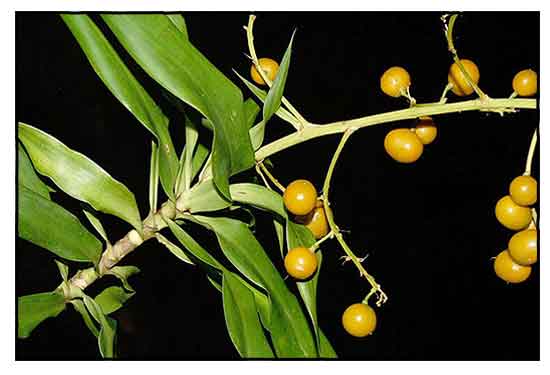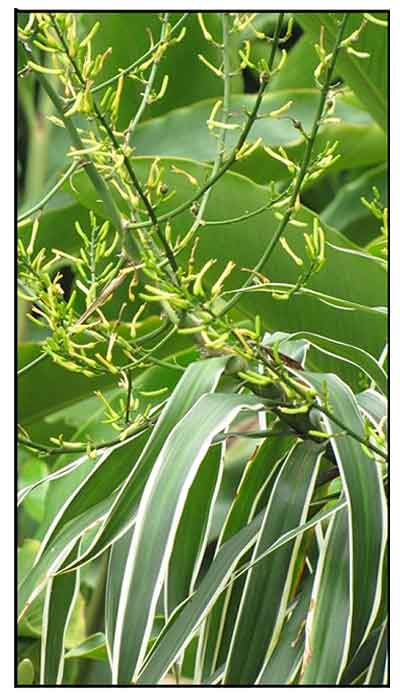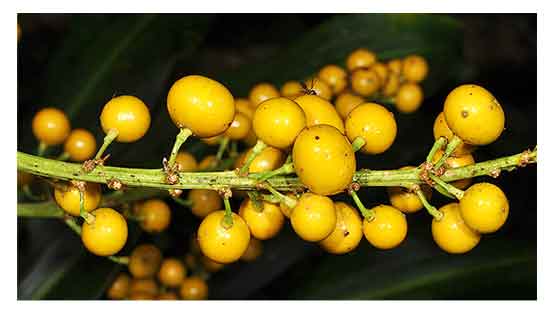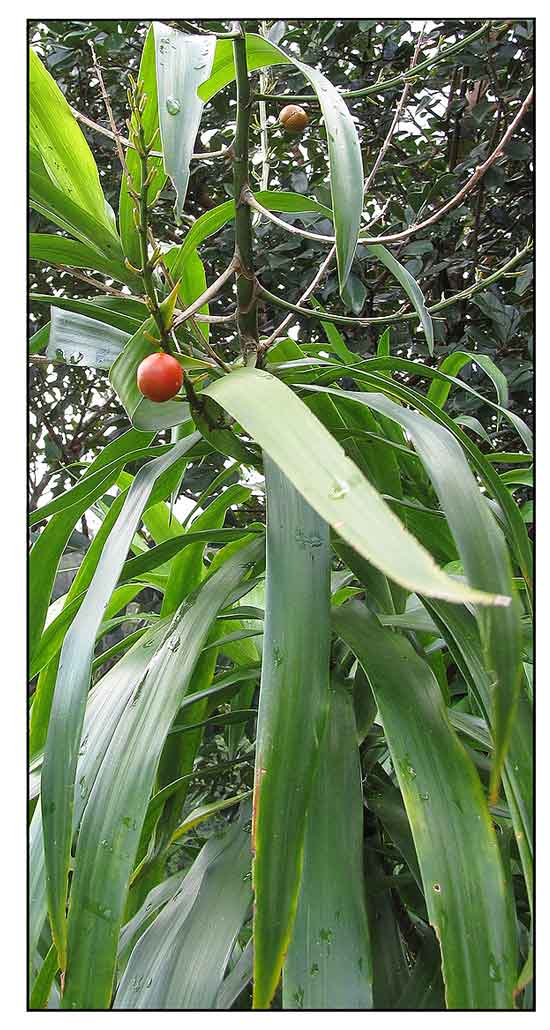 Gen info Gen info
- Dracaena is a genus of about 120 species of trees and succulent shrubs. The formerly accepted genera of Pleomele and Sanseviera are now included in Dracaena. (2)
-
Dracaena angustifolia is a species of Asian tropical forest under-storey plants in the family Asparagaceae. No subspecies are listed.
- Etymology: The genus name Dracaena derives from the romanized form of the Ancient Greek drakaina, meaning "female dragon".
Botany
• Plants shrubby, rhizomatous, 1--3 m tall. Stems simple or few branched; internodes often longer than wide; bark grayish, smooth. Leaves spaced along distal part of stems, subsessile or indistinctly petiolate; petiole to 1 cm, base not completely covering internode; leaf blade nearly sword-shaped to linear-oblanceolate, 20--45 × 1.5--5.5 cm. Inflorescence terminal, branched, 30--50 cm; rachis glabrous. Flowers in clusters of 2 or 3; pedicel 7--8 mm, articulate distally or near apex. Perianth greenish white, 1.9--2.3 cm; tube 7--8 mm; lobes 1.1--1.6 cm. Filaments filiform; anthers 2--3 mm. Style 5--8 × as long as ovary. Berry orange, globose, 0.8--1.2 cm in diam., 1- or 2-seeded. (Flora of China)
Distribution
- Native to the Philippines.
- Also native to
Andaman Is., Assam, Bangladesh, Bismarck Archipelago, Borneo, Cambodia, China South-Central, East Himalaya, Hainan, Jawa, Laos, Lesser Sunda Is., Malaya, Maluku, Myanmar, New Guinea, Nicobar Is., Northern Territory, Queensland, Solomon Is., Thailand, Vietnam. (1)
 Constituents Constituents
- Study of methanol extracts yielded drangustosides A; (R)-2-(3-hydroxy-5-methoxyphenyl)-5-methoxy-8-methylchroman-7-ol; 5,7-dihydroxy-3-(4-hydroxybenzyl)-8-methyl-4H-chromen-4-one; 5,7-dihydroxy-3-(4-hydroxybenzyl)-4H-chromen-4-one; and namonin A. (see study below) (4)
- Study of MeOH extract isolated two new steroidal saponins, namely drangustosides A-B (1-2), together with 8 known compounds (3-10).
(see study below) (6)
- Bioassay guided fractionation of dichloro- methane extract of D. angustifolia leaves isolated and characterized three highly potent anti-mycobacterial constituents: ergosterol-5,8-endoperoxide, linoleic acid, and E-phytol.
(see study below) (10)
- Study of MeOH extract Nam ginseng (roots and rhizomes of D. angustifolia) isolated three spirostanol sapogenins, namogenins A-C (1-3), four spirostanol saponins, namosins A-D (4-7), a furostanol saponin, namonin E (8), and a pregnane glycoside, namonin F (9), along with 8 known steroids saponins (10-17). (see study below) (13)
- Study of stems isolated a new lignanolide, angudracanolide A, together with 3 known lignans (2-4) and 3 known phenylpropanoids (5-7). (see study below) (16)
- Study of stems isolated
ten compounds: four new flavonoid derivatives, tazettone H (1), (2R)-3′,7-dihydroxy-5′,5-dimethoxy-8-methylflavone (2), (2R)-4′,7-dihydroxy-3′,5-dimethoxy-8-methylflavone (3), (2R)-4′,7-dihydroxy-5-methoxy-8-methylflavanone (4), and six known compounds: 4′,5-dihydroxy-7-methoxy-8-methylflavan (5), 4′-hydroxy-5,7- dimethoxy-8-methylflavan (6), (3S)-3,5,7-trihydroxy-4′-methoxy homoisoflavonone (7), 7-dihydroxy-6-methyl-3-(4′-hydroxybenzyl)chroman-4-one (8), desmethy-lisoophiopogonone B (9), and 5,7-dihydroxy-3-(4′-hydroxybenzyl) chromone (10). (see study below) (18)
- Green color of Suji plants come from chlorophyll compound contained inside, located in the intercellular lamella organelle called a chloroplast, its existence protected by proteins that form a protein-chlorophyll complex. The complex is surround by protein-lipid bilayer, which makes the chlorophyll stable. Suji leaves have 73.25% moisture, which contains 2524.6 pp, chlorophyll a and 1250.3 chlorophyll b. There is little difference in chlorophyll a and b contents. (19)
Properties
- Studies suggested anti-inflammatory, immunomodulatory, antibacterial, antidiabetic, α-glucosidase and α-amylase inhibitory, anti-acne, antimycobacterial properties.
Parts used
Leaves, underground parts.
 Uses Uses
Edibility
- Very young leaves, cooked and eaten as a side dish with rice.
- Balinese people cook Suji leaf shoots as side dish.
- Fruits are edible, roasted.
Folkloric
- In the Philippines, roots applied to prevent or treat insect bites.
-
In Indonesia, used traditionally to treat headaches, gonorrhea, and beriberi. (5)
- Decoction of underground parts used as tonic and for treatment of asthma, diarrhea, and inflammation. (6)
- Juice squeezed from boiled leaves drunk as remedy for asthma and breathing difficulty. Decoction of leaves given to people suffering weight loss and poor appetite. (16)
- Used t0 fertilize hair growth, render the hair long and pliant. (19)
- In Vietnam, suji roots and rhizomes are used as tonic and treatment of leukemia. (19)
- In Laos, stems and roots used to treat rheumatism and muscle pain. (20)
Others
- Colorant: Leaves are rich in chlorophyll pigment that produces a natural green color. In Indonesia, the main use of Suji leaves is as food colorant. (5) Pounded leaves mixed with water yields a green juice used for coloring Indian pastry made of glutinous rice. (16) Provides color for various drinks, sweets, puddings, and desserts. Green color from leaf extract also used as dye for paper, castor oil, and coconut oil. Also used for coloring fabrics in home made Indonesian batik production. (19)
 Studies Studies
• COX-2 Inhibitory / Anti-Inflammatory: Study reports on the extraction of leaves, stem bark, and root back using methanol as solvent. There were variations in contents of flavonoids and total phenols among extracted components, with stem bark showing highest concentration. Analysis yielded drangustosides A; (R)-2-(3-hydroxy-5-methoxyphenyl)-5-methoxy-8-methylchroman-7-ol; 5,7-dihydroxy-3-(4-hydroxybenzyl)-8-methyl-4H-chromen-4-one; 5,7-dihydroxy-3-(4-hydroxybenzyl)-4H-chromen-4-one; and namonin A, which were evaluated against the COX-2 protein target. Binding affinities and interactions were compared with COX-2 inhibitors like celecoxib, rofecoxib, and valdecoxib, and classical NSAIDs like aspirin, ibuprofen, and indomethacin. Molecular docking indicated the five compounds have favorable binding affinity energies and exhibit binding site similarity with commonly used drugs, suggesting potency to act as anti-inflammatory drugs targeting COX-2. (4)
• Immunomodulatory / Leaves: Study evaluated the immunomodulatory activity of fractions obtained from suji dried leaves macerated with 96% ethanol and using invitro phagocytic macrophage assay. Parameters used were phagocytic index (PI), and phagocytic capacityy (PC). Macrophage phagocytic invitro assay showed fractions of suji leaf EE could improve phagocytic activity of macrophages. Fraction 3 was the most active fraction, with highest PC and PI values. TLC revealed F3 contained terpenoids and flavonoids. (5)
• Anti-Inflammatory Saponins / Whole Plant: Study of MeOH extract isolated two new steroidal saponins, namely drangustosides A-B (1-2), together with 8 known compounds (3-10). Compounds 1 and 2 showed anti-inflammatory activity by superoxide generation and elastase release by human neutrophils in response to fMLP/CB. (6)
• Anti-Bacillary Dysentery / Potassium Source / Leaves: Study evaluated the antibacterial activity of ethanol extract of bay (Syzygium polyanthum) and suji (Dracaena angustifolia) leaves against Shigella dysenteriae. Results showed the ethanol extract of both leaves had antibacterial activity against S. dysenteriae with MBC values in the range of 10-20% w/v. Comparative effectiveness of suji leaf to bay leaf was 1:0.4, Potassium levels of ethanol extract of bay and suji leaves were 1.027% and 3.795%. respectively. Both suji and bay leaves have potential as supplier of potassium in patients with hypokalemic dysentery. (7)
• α-Amylase and α-Glucosidase Inhibitory / Synergism with Acarbose: Previous study showed
α-glucosidase inhibitory invitro, suggesting potential for alleviating glucose dysregulation. Study evaluated combination with acarbose. Seven compounds, including flavonoid derivatives, amides, and aromatic derivatives, with higher α-glucosidase inhibitory efficiencies were confirmed. Competitive/mixed candidates and acarbose interacted synergistically or additively on α-glucosidase. Despite mild effects on α-amylase, considerable α-glucosidase inhibitory efficiencies and potential synergy with acarbose were exhibited by natural candidates. A stable ligand, human α-glucosidase, predicted by simulations, provide useful information for application of D. angustifolia in diabetes treatment. (8)
• Anti-Acne / Antibacterial / Cytotoxic / Nanoemulsion: Study evaluated the cytotoxic and antibacterial properties of suji leaves against Propionibacterium acnes and Staphylococcus aureus in nanoemulsion. Ethanol extract of leaves contained alkaloids, phenols, flavonoids, saponins, triterpenoids,and steroids as secondary metabolites. Serum nanoemulsion showed strong antibacterial activity against P. acne and S. aureus at 500 and 750 ppm. IC50 of MTT assay for cytotoxic effect of nanoemulsion of suji leaves was 61.92 µg/mL, indicating moderate activity against prepuce cells, which was used as a model of acne prone skin. Results showed suji leaf ethanol extract has antibacterial, cytotoxic, and potential as anti-acne agent. (9)
• Anti-Mycobacterial / Leaves: Bioassay guided fractionation of dichloro- methane extract of D. angustifolia leaves isolated and characterized three highly potent anti-mycobacterial constituents with MICs less than or equal to 2 µg/mL: ergosterol-5,8-endoperoxide, linoleic acid, and E-phytol. Results indicate gradient-array CCC and high-capacity FCPC can facilitate drug discovery efforts from natural products. (10)
• Spirostandol Steroids and Steroidal Saponins / Antiproliferative / Roots and Rhizomes: Study of MeOH extract Nam ginseng (roots and rhizomes of D. angustifolia) isolated three spirostanol sapogenins, namogenins A-C (1-3), four spirostanol saponins, namosins A-D (4-7), a furostanol saponin, namonin E (8), and a pregnane glycoside, namonin F (9), along with 8 known steroids saponins (10-17). All compounds were tested for antiproliferative activity against murine colon 26-L5 carcinoma, human HT-1080 fibrosarcoma, and B-16 Bl6 melanoma cells. Compounds 4, 5, and 10 showed potent antiproliferative activity against HT-1080 fibrosarcoma cells, with IC50s of 0.2, 0.3, and 0.6 µM, respectively, c9omparable to doxorubicin. (13)
• Gold Nanopartices / Reductive Degradation of Methyl Orange: Study reports on the green synthesis of gold nanoparticles (AuNPs) using suji leaf extract and used the AuNPs to reduce methyl orange. Application of Al-bentonite@AuNP as catalyst in the reductive degradation of methyl orange yields a degradation percent of up to 34.5%. (15)
• Lignanolides / Antioxidant / Stems: Study of stems isolated a new lignanolide, angudracanolide A, together with 3 known lignans (2-4) and 3 known phenylpropanoids (5-7). Compounds 1-4 showed antioxidant activity with IC50s of 15, 19, 25, 30 mmol/L, respectively, compared to standard trolox with IC50 of 45 mmol/l. (16)
• Yoghurt Fortified with Leaves: Study evaluated the effect of addition of D. angustifolia leaves (DAL) extract to yogurt set. Results suggest the addition of DAL extract to the yogurt set provides an increase in viscosity, color brightness, yellowish color, organoleptic quality (taste, aroma, and color), total acid, antioxidant activity, and reduces syneresis, reddish color intensity and pH. (17)
• Anti-Inflammatory Flavones / Stems: Study of stems of D. angustifolia isolated four new flavone derivatives (1-4), along with six known flavones. Compounds 2, 9 and 10 displayed weak anti-inflammatory activity with IC50s of 45, 33, and 61 µM respectively. (see constituents above) (18)
Availability
Wild-crafted.
Plants, capsules, leaf powders in the cybermarket. |

![]()



 Gen info
Gen info


